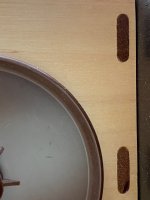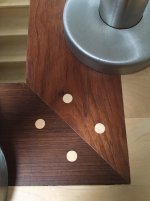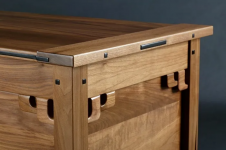With the goal of making attractive exposed Domino tenon joints, we're launching Metric Half-Round Bits in 4,5,6,8 and 10mm diameters. They don't officially launch until tomorrow, but I thought some of you guys might like a chance to get to the head of the line. Shipping will be pretty quick...they were working on the production set-up today.
You are using an out of date browser. It may not display this or other websites correctly.
You should upgrade or use an alternative browser.
You should upgrade or use an alternative browser.
Ultra-Shear Metric Half-Round Carbide Head Bits
- Thread starter jeffinsgf
- Start date
squall_line
Member
- Joined
- Feb 17, 2021
- Messages
- 2,921
Are these going to be smooth bullnose, or incorporate the glue squeeze-out channels that the stock dominos use (I'm not sure if the channels are part of a patent or not, honestly)? Wasn't sure if they were intended for hidden or through joinery a la Morty Jig (which would then also require 'standard' radii?)
luvmytoolz
Member
- Joined
- May 17, 2021
- Messages
- 1,792
That'd be a really nice option to use ebony dominos ala Greene and Greene style for accent!
They're just a bullnose without the ridges. The idea is to fit snugly in the mortise. If you feel the need to create ridges, I've done it with a carving tool about a 1/4" back from the exposed end. I've had equal luck with just not getting carried away with glue application.
Michael Kellough
Member
- Joined
- Jan 23, 2007
- Messages
- 7,096
I’ve been look for these bits for twenty years, or at least ever since the Domino 500 got here.
Cheese
Member
- Joined
- Jan 16, 2015
- Messages
- 12,501
jeffinsgf said:They're just a bullnose without the ridges. The idea is to fit snugly in the mortise.
Jeff, help me understand this. I'm trying to imagine what these bits bring to the table? I've made lots of boxes with exposed Domino joints in a contrasting wood color. While the mortises weren't visually perfect, there was also no attempt on my part to make them visually perfect because they were used on under-bed boxes that spend 99.999% of their time, hidden under a bed. If I needed perfection...I'm sure there were several steps I could have taken that would garner those results.
So my question is, rather than swapping between a router which will cut the perfect mortise and a Domino to cut the functional mortise, why wouldn't a different grind on the Domino cutters possibly produce the result desired?
Here's an example, even from close up it's not a bad Domino mortise but certainly not a perfectly cut mortise. I think some protective tape, a revised cutter geometry or pre-finishing could produce a much better result rather than having to swap between machines.
[attachimg=1]
Attachments
Michael Kellough
Member
- Joined
- Jan 23, 2007
- Messages
- 7,096
[member=44099]Cheese[/member] I’m confused by your post or just don’t understand what you’re getting at.
The new bullnose bits are only for making perfect Dominos without those tell-tale ridges.
The mortise the Domino machine makes is already close enough to perfect.
The new bullnose bits are only for making perfect Dominos without those tell-tale ridges.
The mortise the Domino machine makes is already close enough to perfect.
squall_line
Member
- Joined
- Feb 17, 2021
- Messages
- 2,921
[member=44099]Cheese[/member] I only asked about the ridges on the end profile because that's one of the supposed "key features" to a domino tenon. I didn't intend to flavor it with an opinion for or against the ridges, just commenting because it will likely affect at least one or two people's decisions either way.
If these are intended to be used mainly for visible through-tenons, then a purely round profile on the tenon is the right choice. Alternately, if they are used for blind tenons, this allows one to use the same stock to avoid... well, I don't know, really, since a hidden tenon is probably trapped enough that disparate humidity effects are likely negligible.
It does make me think of some of the super-wide Domino tenons that I've seen people make for themselves, and how much easier it should hopefully be with a dialed-in bullnose bit in the correct diameter instead of finding the correct radius roundover and running it 4 times.
I guess I'm still confused with the focus on the mortise rather than the tenon?
If these are intended to be used mainly for visible through-tenons, then a purely round profile on the tenon is the right choice. Alternately, if they are used for blind tenons, this allows one to use the same stock to avoid... well, I don't know, really, since a hidden tenon is probably trapped enough that disparate humidity effects are likely negligible.
It does make me think of some of the super-wide Domino tenons that I've seen people make for themselves, and how much easier it should hopefully be with a dialed-in bullnose bit in the correct diameter instead of finding the correct radius roundover and running it 4 times.
I guess I'm still confused with the focus on the mortise rather than the tenon?
Michael Kellough
Member
- Joined
- Jan 23, 2007
- Messages
- 7,096
Cheese said:Hey Michael...looking at the photo I just posted, can you see any visual ridges? The perturbing issues I'm seeing is the chip-out on the top layer of veneer.
Not the ridges but the usual little bit of glue filling in the voids left around the not perfectly radiused edges of the Domino.
Michael Kellough
Member
- Joined
- Jan 23, 2007
- Messages
- 7,096
“I guess I'm still confused with the focus on the mortise rather than the tenon?”
That’s what confused me too.
That’s what confused me too.
Cheese
Member
- Joined
- Jan 16, 2015
- Messages
- 12,501
Ya Dewey... [smile], I'm just trying to understand the rationale for the new router bits...but router bits manufactured in any size of mm has to be a good thing. [big grin]
Swapping between and indexing different machines to the proper cut-line for different phases of a project can be problematic to say the least. I've done that before and it's not pretty...just time consuming and fraught with potential mistakes.
Maybe some picture of Festool joints vs Woodpeckers joints would be a good idea. However, I've taken wood dust, mixed it with wood glue and applied it to the mortise, sanded it, and the average person without using a 10X loupe, would never be able to see the difference.
Just a curious guy trying to understand how things work. [tongue]
If using the new router bits, I'd expect every mortise to look like this...but these are tapered plugs and you pound them in for an interference fit. You'll never achieve the look of an interference fit with a mating fit.
[attachimg=1]
Swapping between and indexing different machines to the proper cut-line for different phases of a project can be problematic to say the least. I've done that before and it's not pretty...just time consuming and fraught with potential mistakes.
Maybe some picture of Festool joints vs Woodpeckers joints would be a good idea. However, I've taken wood dust, mixed it with wood glue and applied it to the mortise, sanded it, and the average person without using a 10X loupe, would never be able to see the difference.
Just a curious guy trying to understand how things work. [tongue]
If using the new router bits, I'd expect every mortise to look like this...but these are tapered plugs and you pound them in for an interference fit. You'll never achieve the look of an interference fit with a mating fit.
[attachimg=1]
Attachments
Michael Kellough
Member
- Joined
- Jan 23, 2007
- Messages
- 7,096
“You'll never achieve the look of an interference fit with a mating fit.”
You’re probably right but at least you have a shot with a bit that makes the right radius.
Make the diy Domino a few ‘thou wider than the mortise and taper the leading end.
You’re probably right but at least you have a shot with a bit that makes the right radius.
Make the diy Domino a few ‘thou wider than the mortise and taper the leading end.
The link to these bits is live:
Metric Half Round 2-Flute Router Bits
The purpose became clearer to me after seeing the pictures.
Bob
Metric Half Round 2-Flute Router Bits
The purpose became clearer to me after seeing the pictures.
Bob
Cheese said:jeffinsgf said:They're just a bullnose without the ridges. The idea is to fit snugly in the mortise.
Jeff, help me understand this. I'm trying to imagine what these bits bring to the table? I've made lots of boxes with exposed Domino joints in a contrasting wood color. While the mortises weren't visually perfect, there was also no attempt on my part to make them visually perfect because they were used on under-bed boxes that spend 99.999% of their time, hidden under a bed. If I needed perfection...I'm sure there were several steps I could have taken that would garner those results.
So my question is, rather than swapping between a router which will cut the perfect mortise and a Domino to cut the functional mortise, why wouldn't a different grind on the Domino cutters possibly produce the result desired?
Here's an example, even from close up it's not a bad Domino mortise but certainly not a perfectly cut mortise. I think some protective tape, a revised cutter geometry or pre-finishing could produce a much better result rather than having to swap between machines.
[attachimg=1]
[member=44099]Cheese[/member] I may be totally wrong but I read your comment as you are thinking the router bits Jeff announced are to make the mortise slot? What they are used for is to mill the domino that goes in the standard slot. If I'm totally wrong please just ignore me [wink]
Cheese
Member
- Joined
- Jan 16, 2015
- Messages
- 12,501
OMG...thanks for that Matt, I was thinking on a whole different level. No Matt, you're probably totally right.mattgam said:I may be totally wrong but I read your comment as you are thinking the router bits Jeff announced are to make the mortise slot? What they are used for is to mill the domino that goes in the standard slot. If I'm totally wrong please just ignore me [wink]
So why didn't Woodpeckers explain that to me in the corporate briefing meeting today? [big grin] [big grin]
squall_line
Member
- Joined
- Feb 17, 2021
- Messages
- 2,921
rmhinden said:The link to these bits is live:
Metric Half Round 2-Flute Router Bits
The purpose became clearer to me after seeing the pictures.
Bob
That's exactly how I understood them.
Also, a Benchtop Rout-n-Plane XL was posted (it was teased in a comment thread on the Rout-n-plane Deep Dive recently).
luvmytoolz
Member
- Joined
- May 17, 2021
- Messages
- 1,792
This new product fills a need, not just in doing exposed domino joinery, but also in fixing blunders. If you miscut and want to cover your mistake, these bits can make a good patch.
The more common 6mm bit and the set are still available.
Here's a business idea: Maybe someone would buy the complete set and make batches of tenons (say, in 12" length or longer) in common wood species (ash/oak, mahogany, walnut and maple?) for sale. It may not be too hard to recover the cost of the set plus some change.
The more common 6mm bit and the set are still available.
Here's a business idea: Maybe someone would buy the complete set and make batches of tenons (say, in 12" length or longer) in common wood species (ash/oak, mahogany, walnut and maple?) for sale. It may not be too hard to recover the cost of the set plus some change.
squall_line said:It does make me think of some of the super-wide Domino tenons that I've seen people make for themselves, and how much easier it should hopefully be with a dialed-in bullnose bit in the correct diameter instead of finding the correct radius roundover and running it 4 times.
^This^
I didn't go into this in the product release copy, because I didn't want to scramble the message, but in an upcoming Deep Dive I'm going to make tenons to fit the mid and wide settings. Thinking about it now, I think I'll do it for both through and blind applications and show my carving tool method for hydraulic relief.



